Kecskemét
| Kecskemét | |||
|---|---|---|---|
 |
|||
|
|||
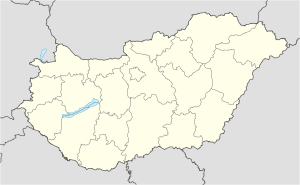 Kecskemét
|
|||
| Coordinates: | |||
| Country | |||
| County | Bács-Kiskun | ||
| Area | |||
| - Total | 321.36 km2 (124.1 sq mi) | ||
| Population (2010) | |||
| - Total | 112,233 |
||
| - Density | 336.96/km2 (872.7/sq mi) | ||
| Time zone | CET (UTC+1) | ||
| - Summer (DST) | CEST (UTC+2) | ||
| Postal code | 6000 | ||
| Area code(s) | 76 | ||
| Website | www.kecskemet.hu | ||
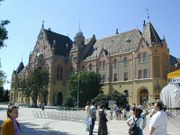
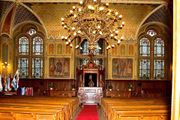

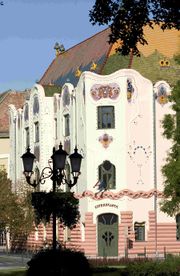
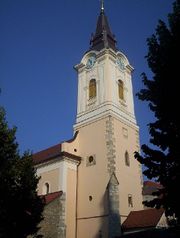
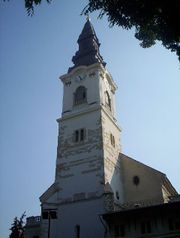
Kecskemét (Hungarian pronunciation: [ˈkɛtʃkɛmeːt]) is a city in the central part of Hungary. It is the 8th largest city of the country, and the county seat of Bács-Kiskun.
Contents |
Location
Kecskemét lies exactly halfway between the capital Budapest and the country's third-largest city, Szeged, 86 kilometres from both of them and almost equal distance from the two big rivers of the country, the Danube and the Tisza. It is also considered to be the northern of two centres of the Hungarian Southern Great Plain (Hungarian: Del-Alföld) region (comprising of the three counties Bács-Kiskun, Békés county and Csongrád county), with the southern one being Szeged, the capital of Csongrád county.
History
Kecskemét is considered to be one of the most well-known and one of the most interesting examples of development among the Hungarian towns. There have been several typical periods in this development and during these periods the character of the town changed a lot.
The first trace of a human in the surrounding of the town is about five thousand years old. The Sarmatian invaded the surrounding of the town in the first century B.C.; since then the area has been inhabited by different cultures. János Hornyik, the first writer of the town's history, believed that he settlement known as Partiskum of the Sarmatian Jazygian was here, but the consensus among historians is that it is more likely permanent settlement occurred only after the conquest. At the beginning of the 13th century, there were seven villages, with a population of 200-300 formed here around the churches, a typical pattern. They were all destroyed by the Mongol Invasion. Some of the villages revived at the time of the Cumanian's colonization.
As Kecskemét was situated at an important trading route, it grew as a customhouse and a market-place; in 1368 it was identified in one of King Louis I of Hungary's charters as an oppidium (town). Later on the active economic life and the settlement's dense population attracted more traders and craftsmen.
During the Turkish invasion, settlers from neighbouring villages sought shelter in the town, which was protected by defensive palisades. They also were escaping the oppression of the spahi landlords. In addition to the protection of its setting, the town of Kecskemét had arranged to pay tax directly to the pasha in Buda, thus gaining his protection and enjoying a special situation.
Kecskemét gradually absorbed the lands of those who had taken refuge in the town. Residents created a large common field for the animals they were breeding. By the beginning of the 18th century, residents held nearly 30,000 cattle, which grazed on an almost 2,000-km-square field.
At the end of the 18th, century animal breeding started to decline and almost one hundred years were needed for another growth that started in the last decade of the previous century when the vine-pest destroyed almost all the wineyards of the country's hilly regions and its damage was less significant on the loose sandy parts. In the 1870s large plantations of vine were formed around the town, which was the economic basis of vineyards of the beginning of the 20th century in Kecskemét. Cottage-type settlements grew up at the vineyards to house workers, a pattern still characteristic of the rural areas around the town. The growth of the wine industry stimulated those of the food industry and trade.
With the accumulation of capital, bourgeois customs were adopted by peasants, contributing to the growth of the town. Such wealth led to construction of the buildings and Kecskemét's main square. This Art Nouveau complex is architecturally significant: the Town Hall, the New College, the Ornamented Palace, the Luther-Palace, the House of Trade (today the House of Young), and the Gentlemen's Casino, now used as a cultural center.
The town's growth suffered in the 1929-33 economic world crisis and Great Depression, followed by the upheaval and destruction of World War II. After 1945, the new Communist government, strongly influenced by the Soviet Union, imposed a different social-political system. Kecskemét's development slowed. Due to reorganization in local government, Kecskemét lost its big territory; several new independent villages were formed in the area. They were economically connected to the town.
The other significant change of that time was that for the first time in the history of Kecskemét the town got a significant administrative role, it became the seat of the country's largest county, Bács-Kiskun in 1950. In the special system of the so called controlled economy it meant political and financial advantages that greatly helped the town distinguish itself from among the towns of the region.
On June 18, 2008, German car manufacturer Daimler announced that it would locate a Mercedes-Benz manufacturing plant in Kecskemet at an investment of 800 million euros. The investment, one of the biggest if not the biggest-ever in the town, will provide work for 2500 people.
In the 19th century it was already part of an important wine district, and it is still known for its barackpálinka, an apricot brandy.
The composer Zoltán Kodály was born here in 1882. The train station has been built on the house of his birth.
Because of the excellent town planning skills of József Kerényi, the historical character of the city was kept alive in modern times.
Economy
German carmaker Mercedes-Benz is planning to open a plant to manufacture parts for their cars, in the near future, i.e. within the next three years, somewhere near the city proper. The Stuttgart-based company said in a statement it would invest €800 million (US$1.24 billion) to build the Kecskemét plant. This is expected to create 2 500 new jobs in the otherwise economically underdeveloped Kecskemét region.[1] According to the plans, more than 100 000 Mercedes vehicles will be produced in the factory from the year 2012.[2]
Geography
Kecskemét was formed at the meeting point of a large sandy region and a sandy yellow soil, its height is 120 meters above sea level. The territory west of the city is covered by wind-blown sand that is characterized by the almost parallel northern-southern sand-hills and the plain lands among them. At the end of the 18th and the beginning of the 19th centuries the pastures were impoverished, at many places destroying the natural vegetation cover and at many places causing movement of the sand that seriously endangered the town, too. The sand that was blown by the wind was later tied up by afforestation and planting fruit and vines.
Climate
The characteristic feature of weather in the Kecskemét region of Kiskunság is extremism, that's why the region is often in the center of attention. The characteristic weather of the Kecskemét region is continental warm, dry, sometimes extreme. The favourable conditions of sunlight make it possible for the region to produce world famous products of some plants like wheat, apricot, red pepper, tomato, etc. The warmest month in Kecskemét is July with an average temperature of 20.9 degrees Celsius, the coldest is January with −1.9 degrees Celsius.
The early spring and late autumn frosts are frequent in the Great Hungarian Plain. The tendency of frost usually disappears only from the middle of April, and from the third decade of October we have to count on having air temperature below 0 °C.
Kecskemét is in the center of Kiskunság one of Hungary's famous regions. The Kiskunság National Park was established in 1975 to preserve the different species of plants and animals that can be found in this region. It is a so called "mosaic" type arranged national park, consisting of units that are not close to each other which is considered a rarity in the international sense as well.
Demographics
Kecskemét has 107,267 residents (2001). The population is homogeneous with a Hungarian majority. There are a few thousand of the Roma minority living in the city; they formed their independent minority government in 1994. (95% Hungarian; 0.8% Roma; 0.4% German; 0.2% Slovakian; 4.8% other.)
City parts of Kecskemét
| Historical populations | ||
|---|---|---|
| Year | Pop. | %± |
| 1870 | 32,830 | — |
| 1880 | 35,122 | 7.0% |
| 1890 | 38,439 | 9.4% |
| 1900 | 46,059 | 19.8% |
| 1910 | 52,270 | 13.5% |
| 1920 | 55,153 | 5.5% |
| 1930 | 58,169 | 5.5% |
| 1941 | 63,256 | 8.7% |
| 1949 | 61,730 | −2.4% |
| 1960 | 71,226 | 15.4% |
| 1970 | 84,482 | 18.6% |
| 1980 | 96,882 | 14.7% |
| 1990 | 102,516 | 5.8% |
| 2000 | 105,606 | 3.0% |
| 2010 | 112,233 | 6.3% |
Kecskemét is divided into 21+1 sections.
- Belváros (Downtown)
- I. Árpádváros (Árpádtown)
- II. Máriaváros (Marytown)
- III. Széchenyiváros (Széchenyitown)
- IV. Bethlenváros (Bethlentown)
- V. Rákócziváros (Rákóczitown)
- VI. Erzsébetváros (Elisabethtown)
- VII. Kossuthváros (Kossuthtown)
- VIII. Hunyadiváros (Hunyaditown)
- IX. Szent István-város (Műkertváros, Szolnoki-hegy) (Saint Stephen town)
- X. Szent László-város (Rendőrfalu) (Saint Ladislaus town)
- XI. Alsószéktó (Szeleifalu)
- XII. Felsőszéktó (Petőfiváros, Sutusfalu)
- XIII. Talfája
- XIV. Katonatelep
- XV. Repülőtér (Reptéri-lakótelep)
- XVI. Matkó
- XVII. Kadafalva
- XVIII. Szarkás
- XIX. Hetényegyháza
- XX. Méntelek
- XXI. Borbáspuszta
Tourist sights
- City Hall
- "Cifra Palota"
- Old Church
- Synagogue
- József Katona Theatre
Gallery
 The seven Hungarian Grand Princes close their so called "blood-pact", with which they unified the seven Hungarian tribes. |
 |
 Folk Art |
 Kodály Zoltán Conservatoire |
 The Great Church |
 |
 Piarist Gimnasium |
 Piarist Church |
 Kecskemét Theater |
 Downtown |
 St. Miklós Church |
 Kecskemét Synagogue |
International relations
Twin towns — Sister cities
Kecskemét is twinned with:
 Aomori, Japan
Aomori, Japan Arcueil, France
Arcueil, France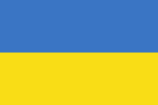 Berehove, Ukraine
Berehove, Ukraine Coventry, United Kingdom
Coventry, United Kingdom Dornbirn, Austria
Dornbirn, Austria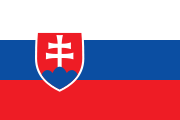 Galanta, Slovakia
Galanta, Slovakia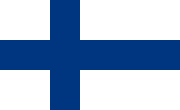 Hyvinkää, Finland
Hyvinkää, Finland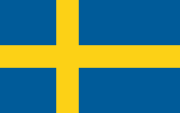 Lidköping, Sweden
Lidköping, Sweden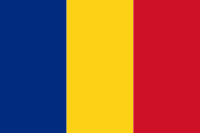 Târgu Mureş, Romania
Târgu Mureş, Romania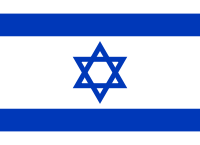 Nahariya, Israel
Nahariya, Israel Rüsselsheim, Germany
Rüsselsheim, Germany Simferopol, Ukraine
Simferopol, Ukraine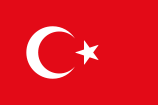 Tekirdağ, Turkey
Tekirdağ, Turkey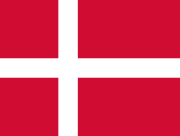 Viborg, Denmark
Viborg, Denmark
Miscellaneous topics
The name of the city stems from the Hungarian word kecske meaning 'goat'.
The Vice President of the German minority in Kecskemet is Ms Rozalia Neuendorf. Since March 19, 2007 there's Minority self-government of Croats in Kecskemét.[3]
Local regular military unit
The MH 59th "Szentgyörgyi Dezső" Air Base, the only jet fighter unit of the Magyar Honvédség stations in the city.
List of famous residents
- András Gáspár (1804–1884) Hungarian General
- János Hornyik (1812–1885) historian
- József Katona (1791–1830) author
- László Kelemen (1760–1814) president of the first Hungarian Theater
- Zoltán Kodály (1882–1967) Hungarian composer, ethnomusicologist, educator, linguist and philosopher
- Kálmán Latabár (1902–1970) actor, comedian
- Akos Konya (1974–) Ultramarathoner
References
- ↑ http://www.iht.com/articles/ap/2008/06/18/business/EU-FIN-COM-Germany-Daimler.php
- ↑ http://www.logsped.hu/mercedes_kecskemeti_gyara_az_eredeti_tervek_szerint_epul.htm
- ↑ (Croatian) Hrvatski glasnik br. 14/2007.PDF (724 KB) Utemeljena županijska hrvatska samouprava
External links
|
|||||||||||||||||
|
||||||||||

